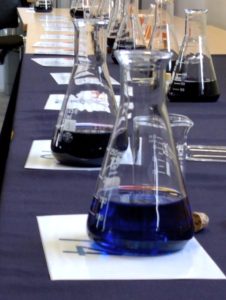 Clock reactions are amongst the most dramatic and visually pleasing chemical demonstrations. Typically after a clock reaction has been started there is a period during which no noticeable change takes place and then a change (often in colour) occurs. This sudden and unexpected nature of the change gives clock reactions their charm and visual appeal.
Clock reactions are amongst the most dramatic and visually pleasing chemical demonstrations. Typically after a clock reaction has been started there is a period during which no noticeable change takes place and then a change (often in colour) occurs. This sudden and unexpected nature of the change gives clock reactions their charm and visual appeal.
The activity described here is based on the so-called iodine clock reaction. When a solution of hydrogensulphite (or bisulphite) ions (HSO3-) is mixed with a solution of iodate (IO3-) ions and a starch solution, the mixture remains colourless for a time and then suddenly turns blue. The clock period (the time from mixing to colour change) can be changed by varying the concentrations of the reactants.
The aim in this particular activity is to create a series of solutions for which the clock period has been predicted based upon analysis of experimental data which the pupils will generate. And then to attempt to set these to music!



